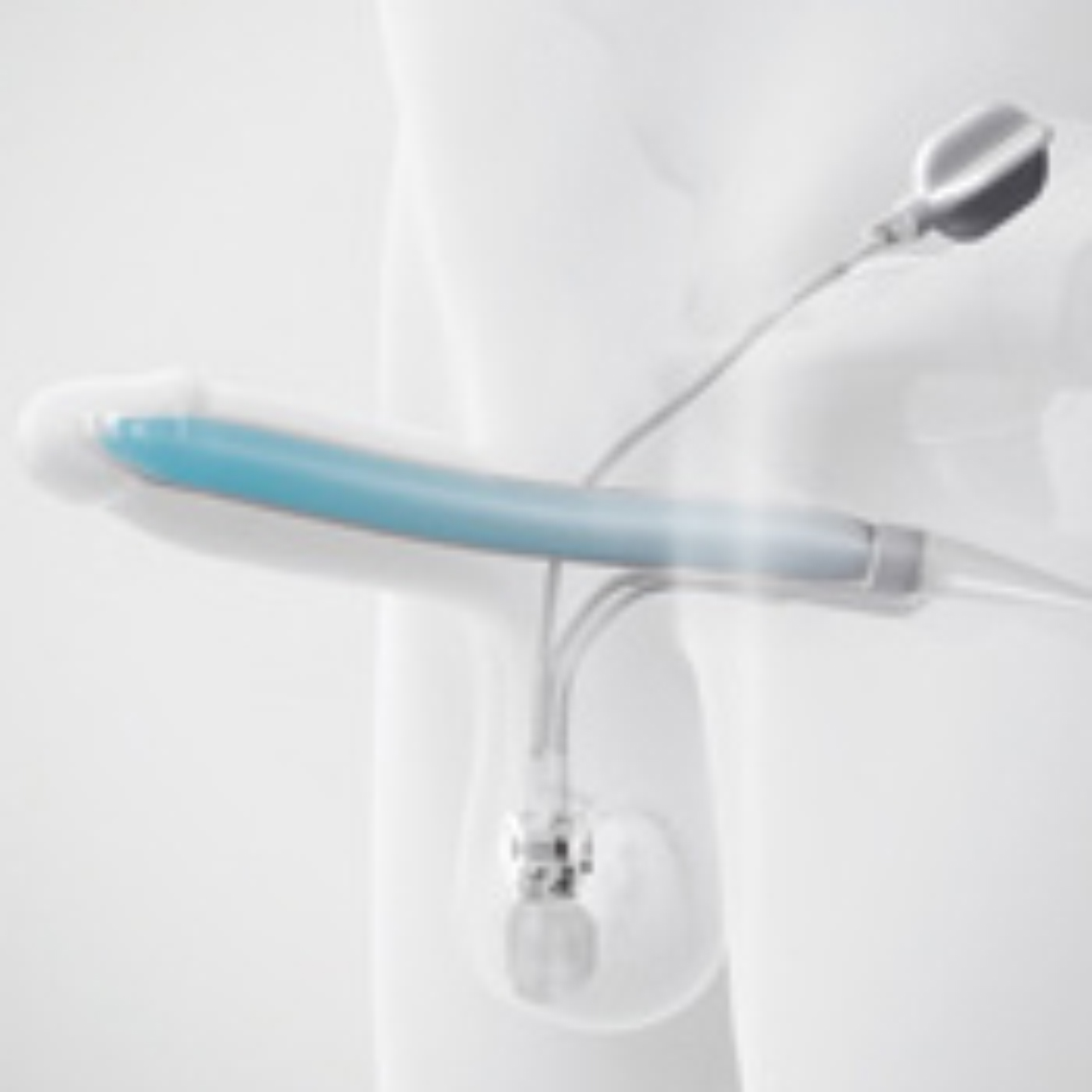Titan® Inflatable Penile Implant:
Reignite performance
Designed to look and feel like a natural erection, the Titan implant puts you back in control of your body – and your confidence.1
Simply discreet
Completely hidden inside the body, the Titan penile implant is designed to mimic the look and performance of a natural erection. It’s easy to activate, ready whenever you are, and no one knows it’s there but you. Custom-fit to your natural length, the Titan implant has three parts.
Key features

Easy to use and always ready

Completely concealed and looks natural when flaccid

Maximizes penis girth2 and rigidity3
Engineered for performance
The Titan penile implant is made with a unique material called Bioflex®, which is safe for your body and stronger than silicone.1 The Bioflex material was specifically engineered for penile implants to make them stronger3 and more durable4 than other penile implants available.

more durable than the competition4

more rigid than the competition3

more girth than the competition2
Increased durability and rigidity may enhance penetration performance during sexual intercourse, for greater confidence in a variety of sexual positions.3,4,5 Maximized girth may lead to increased partner stimulation and satisfaction.6
ED Explained
Titan Penile Implant
In this video, Dr. Marah Hehemann explores the benefits of the Titan penile implant, including how easy it is to use and how the implant’s Bioflex material makes the difference.

Satisfaction rate for recipients of the Titan® Penile Implant7

Satisfaction rate for partners of Titan Penile Implant recipients7
Implant inflation and deflation demos
Titan® Inflatable Penile Implant
Inflation and deflation animated demonstration
Titan® Inflatable Penile Implant
Inflation and deflation patient demonstration
Common questions about penile implants
Cost matters, but you have options
Penile implants are generally covered by most insurance plans, including Medicare. Whether you’re fully covered or will be paying out of pocket, it’s important to understand your options.

Find a local implant doctor
If you are ready to talk to a doctor about the possibility of receiving a penile implant, use our physician directory to find a qualified urologist specializing in ED near you.

Have questions? Need support? We’re here to help!
Call or chat online with a member of our Coloplast Guided Support team. We can answer your questions and connect you with a local qualified urologist who specializes in ED.
References
1 Data on file at Coloplast.
2 Pescatori ES, Goldstein I. Intraluminal device pressures in 3-piece inflatable penile prostheses: the “pathophysiology” of mechanical malfunction. J Urol. 1993 Feb;149(2):295-300.
3 Scovell JM, Ge L, Barrera EV, Wilson SK, Carrion RE, Hakky TS. Longitudinal and Horizontal Load Testing of Inflatable Penile Implant Cylinders of Two Manufacturers: An Ex Vivo Demonstration of Inflated Rigidity. J Sex Med. 2016 Nov;13(11):1750-1757.
4 Pritchard, Charles, MD, et al. “Comparison of AMS 700 CX and Coloplast Titan Inflatable Penile Prosthesis Cylinders Subjected to In-Vitro Cyclic Buckling.” Sexual Medicine Society of North America Fall Meeting, Poster 111, 2008.
5 Fernandez-Crespo RE, Buscaino K, Carrion R. Optimizing Outcomes in Penile Implant Surgery. Urol Clin North Am. 2021 Nov;48(4):527-542.
6 Prause N, Park J, Leung S, Miller G. Women’s Preferences for Penis Size: A New Research Method Using Selection among 3D Models. PLoS One. 2015 Sep 2;10(9):e0133079.
7 Garber BB. Mentor Alpha 1 inflatable penile prosthesis: patient satisfaction and device reliability. Urology. 1994 Feb;43(2):214-7.
8 Coleman E, Listiak A, Braatz G, Lange P. Effects of penile implant surgery on ejaculation and orgasm. J Sex Marital Ther. 1985 Fall;11(3):199-205.
9 Xie D, Nicholas M, Gheiler V, Perito D, Siano L, Kislinger I, Nehrenz GM, Klopukh B, Bianco FJ, Perito P, Gheiler E. A prospective evaluation of penile measures and glans penis sensory changes after penile prosthetic surgery. Transl Androl Urol. 2017 Jun;6(3):529-533.
10 Treatment for Erectile Dysfunction. NIH: National Institute of Diabetes and Digestive and Kidney Diseases. https://www.niddk.nih.gov/health-information/urologic-diseases/erectile-dysfunction/treatment. Accessed May 2024.
11 Miller LE, Khera M, Bhattacharyya S, Patel M, Nitschelm K, Burnett AL. Long-Term Survival Rates of Inflatable Penile Prostheses: Systematic Review and Meta-Analysis. Urology. 2022 Aug;166:6-10. 24.
PM-33079
Important safety information
Titan® & Titan Touch Inflatable Penile Prosthesis
The Titan Inflatable Penile Prosthesis is a surgically implanted mechanical penile implant intended for the treatment of erectile dysfunction in men. The Titan implant is a 3-piece fluid-filled system manually operated to produce and sustain an erection for sexual intercourse.
Indications
The Titan Inflatable Penile Prosthesis is indicated for male patients with erectile dysfunction who are considered to be candidates for implantation of a penile prosthesis.
Contraindications
The Titan implant is not for use in patients who have one or more of the following conditions: 1) have an active infection, particularly urinary tract or genital infection, 2) are sensitive or allergic to silicone or polyurethane, 3) have ongoing difficulty urinating or emptying the bladder (e.g., bladder outlet obstruction or neurogenic bladder), or 4) unwilling to undergo any further surgery for device revision.
Warnings
Patients should consider the warnings, precautions and potential complications associated with the use of this product, which may include the following: potential for resurgery (note: device is not a lifetime implant). Implantation makes latent natural erections, as well as other interventional treatment options, impossible. Implantation may result in penile shortening, curvature or scarring. Pre-existing abdominal or penile scarring or contracture may make surgical implantation more complicated or impractical. Diabetic, as well as immunocompromised patients, may have an increased risk of infection which could result in permanent damage to tissue/organs. Excessive stresses from rigorous exercise and vigorous masturbation/intercourse could lead to device damage. Certain stresses and pressures (straddle seating, obesity, etc.) could lead to involuntary inflation or deflation. Post-implant penile size, girth and angle can vary based on patient anatomy, implant size, level of inflation, and presence of Peyronie’s disease.
Precautions
Patients with spinal cord injury may have an increased risk of infection. This device may be used to treat erectile dysfunction in the presence of Peyronie’s disease. Although the implant is not visible, depending on the placement (submuscular) the reservoir may be palpable.
Patients should consider the following factors which could lead to increased risk of failure and can be critical to the eventual success of the procedure: ability and willingness of the patient to follow instructions; associated psychological status (e.g., psychogenic erectile dysfunction, inappropriate attitude or motivation); health conditions which hamper sexual activity (such as severe angina) may prevent successful use of this device; manual dexterity problems; and lack sufficient manual dexterity or strength necessary to operate the device.
Impact injuries to the pelvic or abdominal areas (e.g., sports injuries) can result in damage to the implant which may necessitate replacement of the device. Contracture of tissue around the pump can cause unnatural firmness in the scrotum and involuntary inflation or deflation. The device may fail to deflate and/or deflation of the device may be slow or difficult for some patients. Device malfunctions may result in the inability to inflate or deflate the device. Removal of the device without timely reimplantation of a new implant may complicate subsequent reimplantation.
Potential Complications
Adverse events are known to occur with penile protheses procedures and implants; some may require revision surgery or removal of the implant. Adverse events following penile protheses implantation may be new onset (de novo), persistent, worsening, transient, or permanent.
Adverse events may include but are not limited to: inability to pull foreskin back from tip of uncircumcised penis (acquired phimosis); abnormal wound healing/adhesion/scar tissue; bladder storage symptoms/urinary retention; tightening, shortening, deformity or curvature of penis (capsular contracture, induration); discomfort/pain; injury to tissue or organs (perforation/erosion/extrusion) resulting in damage or loss of tissue (necrosis); open tunnel between tissue or organs (fistula); foreign body reaction/allergic reaction/sensitivity; bleeding/hemorrhage or collection of blood or fluid outside of tissue or vessels (hematoma/seroma); hernia; Infection/urinary tract infection; redness or swelling (inflammation/edema); difficult or painful intercourse (dyspareunia/sexual dysfunction); obstruction/occlusion; numbness or decreased sensation (e.g., hypoesthesia); and urinary incontinence. The occurrence of these events may require one or more subsequent surgeries which may or may not always fully correct the complication.
This treatment is prescribed by your physician. Discuss the treatment options with your physician to understand the risks and benefits of the various options to determine if an inflatable penile implant is right for you.
Caution: Federal law (USA) restricts this device to sale by or on the order of a physician.
PM-15451 / Feb 2024




